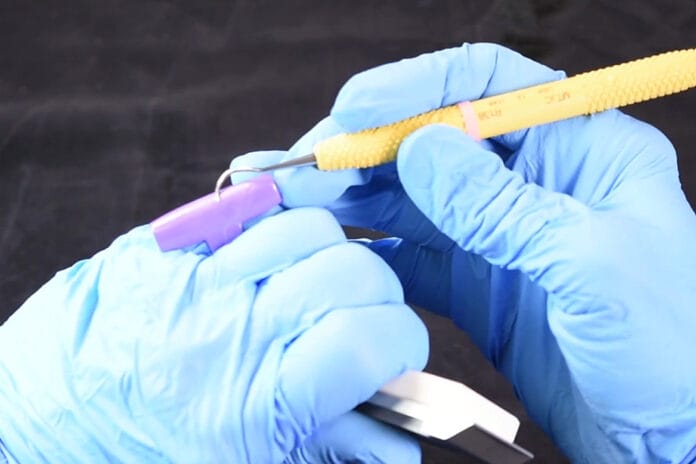Disclosure: This quiz is sponsored content from PDT Dental as part of our sponsored partner program.
Let’s test your instrument sharpening knowledge!
Test Your Dental Instrument Sharpening Knowledge
1. A sharp cutting edge allows for which of the following?
A sharp cutting edge allows for:
- Easier calculus removal: A sharp cutting edge grabs the calculus deposit and removes it more efficiently. A dull cutting edge can increase the possibility of burnishing rather than removing calculus and nicking, grooving, or scratching the tooth surface.
- Improved stroke control: A sharp cutting edge increases tactile sensitivity and reduces force allowing for better control of the instrument. Dull cutting edges require excessive force increasing the likelihood of losing control of the stroke and possibly injuring the patient or yourself.
- Reduced number of strokes: A sharp cutting edge reduces the number of strokes needed to remove calculus deposits saving energy and time.
- Increased patient comfort: A sharp cutting edge reduces lateral force and requires fewer working strokes, which improves patient comfort. It also helps prevent unnecessary gingival tissue trauma, which can be uncomfortable for the patient.
- Reduced clinician fatigue: Just as fewer strokes and less lateral pressure improve patient comfort, it also decreases clinician fatigue. Additionally, sharp cutting edges reduce musculoskeletal injuries due to the lighter lateral pressure and pinch force needed.
Gehrig, J.S., Sroda, R., Saccuzzo, D. (2020). Fundamentals of Periodontal Instrumentation and Advanced Root Instrumentation, Enhanced Edition. Jones & Bartlett Publishers.
2. Studies indicate that the cutting edges of curettes should be sharpened after 15 to 40 calculus removal strokes.
As instruments are used in working strokes, such as those to remove calculus, minute particles of metal are worn away. Loss of metal from the working end leads to changes in the cutting edge, making the edge more rounded and ineffective at removing calculus. Therefore, sharpening instruments after 15 to 40 working strokes is necessary.
Gehrig, J.S., Sroda, R., Saccuzzo, D. (2020). Fundamentals of Periodontal Instrumentation and Advanced Root Instrumentation, Enhanced Edition. Jones & Bartlett Publishers.
3. With instrument designs and materials varying, it is important to know when an instrument should be replaced. What percentage of size reduction correlates with a significant reduction in working end strength, indicating the need to replace the instrument?
Scalers and curettes have a limited lifespan and should be discarded and replaced when the integrity of the instrument has been compromised due to sharpening and use. Therefore, instruments with a size reduction of 20% should be discarded and replaced to prevent breaking and ensure proper calculus removal.
Reduced size of the working end can lead to broken tips during instrumentation that can cause tissue damage and periodontal abscesses if not properly removed. A more serious consequence of broken instruments is the possibility of aspiration. If a broken tip cannot be retrieved, the patient will need a chest x-ray to ensure the tip was not aspirated into the lungs.
Gehrig, J.S., Sroda, R., Saccuzzo, D. (2020). Fundamentals of Periodontal Instrumentation and Advanced Root Instrumentation, Enhanced Edition. Jones & Bartlett Publishers.
4. A clinician who is not knowledgeable about working end design can alter the characteristics and design of an instrument with improper sharpening techniques.
The need to understand instrument design and characteristics is integral to the sharpening process. This will help guide the technique and reduce the risk of altered characteristics and design that could contribute to instrument fracture and ineffective calculus removal.
Gehrig, J.S., Sroda, R., Saccuzzo, D. (2020). Fundamentals of Periodontal Instrumentation and Advanced Root Instrumentation, Enhanced Edition. Jones & Bartlett Publishers.
5. An incorrectly sharpened instrument is far less effective for calculus removal and may fracture easily. To maintain the 70-80 degree internal angle of the blade at the cutting edge, the visible angle at which the stone should be placed against the blade is 110 degrees.
The internal angle of an instrument's blade is between 70 and 80 degrees, so the visible angle at which a sharpening stone should be placed against the blade is 110 degrees. While a universal curette and sickle scaler may have a face-to-blade angulation at 90 degrees depending on the specific instrument, a Gracey has an offset blade with a 70-degree angle to the lower shank. With all of these angulations to consider, many clinicians struggle with visualizing an instrument's precise degree of angulation to the stone needed to sharpen properly.
The Gleason Guide from PDT eliminates the need for visualizing angulation during sharpening. When the instrument and stone are positioned at the correct angle using the Gleason Guide, a solid, consistent bevel can be obtained more readily, which helps maintain the original design characteristics of the cutting edge without any guesswork.
The Gleason Guide also reduces the risk of creating unintended bevels, which can make the cutting edge unable to adapt effectively to the tooth leading to ineffective calculus removal. Because of its ease of use, you can sharpen your instruments more often to maintain the cutting edge's original design, extending the instrument's life and improving patient and clinician comfort.
The Gleason Guide offers three separate rests/guides for sharpening, one for universal curettes and sickle scalers, another for Graceys, and the last for the toe of the instrument and periodontal files. The Gleason Guide can be used for any instrument regardless of the manufacturer; it is not exclusive for use only with PDT instruments.
Gehrig, J.S., Sroda, R., Saccuzzo, D. (2020). Fundamentals of Periodontal Instrumentation and Advanced Root Instrumentation, Enhanced Edition. Jones & Bartlett Publishers.
PDT Gleason Guide Sharpening System. (n.d.). Paradise Dental Technologies. https://www.pdtdental.com/gleason-guide/
6. Which of the following is a major objective for instrument sharpening?
The sharpening process has three major objectives:
- To produce a functionally sharp edge
- To maintain the contours required for the intended use of the instrument
- Not to reduce too much blade material leading to a reduced working life
Unfortunately, all three objectives are not always met, which can lead to reduced instrument working life. Not maintaining an instrument's design characteristics makes it more difficult to remove calculus. Or worst of all, after working hard to sharpen, if done incorrectly, you may be left with an instrument that still does not have a functionally sharp edge.
Lowe, A. (2015). The Cutting Edge of Dental Instruments. BDJ Team. 2015; 1: 20-22. https://www.nature.com/articles/bdjteam201527
7. An instrument's cutting edge quality can be defined by fineness, delicacy, and durability.
Fineness, delicacy, and durability define the quality of an instrument's cutting edge. The fineness of the edge refers to the smoothness. The delicacy refers to the angle at which the facial and lateral surfaces approach each other. Durability refers to the hardness of the material used to make the cutting edge.
Balevi, B. Engineering Specifics of the Periodontal Curet's Cutting Edge. J Periodontol. 1996; 67(4): 374-378. https://pubmed.ncbi.nlm.nih.gov/8708962/
8. The moving instrument technique produces a precise, defined cutting edge. In contrast, the moving stone technique produces bevels and wire edges.
The moving instrument technique is utilized by moving the instrument along the stone. The moving stone technique is when the stone is moved along the instrument. "Researchers found that the technique that produces the most precise cutting edge without wire edges and irregularities is the moving instrument technique."
Gehrig, J.S., Sroda, R., Saccuzzo, D. (2020). Fundamentals of Periodontal Instrumentation and Advanced Root Instrumentation, Enhanced Edition. Jones & Bartlett Publishers.












